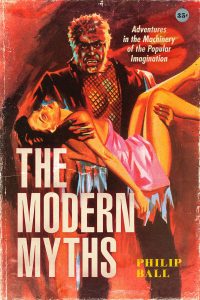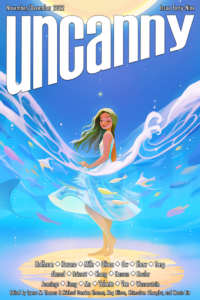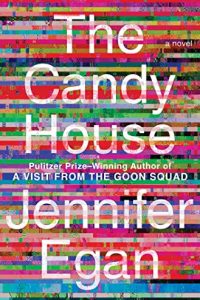Alvaro Zinos-Amaro Reviews The Modern Myths: Adventures in the Machinery of the Popular Imagination by Philip Ball
 The Modern Myths: Adventures in the Machinery of the Popular Imagination, Philip Ball (University of Chicago Press 978-0226719269, $30.00, 368pp, hc) May 2021.
The Modern Myths: Adventures in the Machinery of the Popular Imagination, Philip Ball (University of Chicago Press 978-0226719269, $30.00, 368pp, hc) May 2021.
Though I endeavor, in this space, to bring to your attention genre-related volumes of only the most recent or imminent vintage, I would be remiss to let Philip Ball’s The Modern Myths pass unnoticed, even if I’m a little tardy to the party. Ball’s fascinating study concerns itself with seven stories from the 18th-century through the present that have become “modern myths,” a concept he blueprints in the opening chapter and elaborates along the way. Of the seven narratives in question – Robinson Crusoe (1719), Frankenstein (1818), The Strange Case of Dr. Jekyll and Mr. Hyde (1886), Dracula (1897), The War of the Worlds (1897), the Sherlock Holmes stories (1887–1927), and Batman (1939–) – five are clearly SF/F/H genre works, and for Ball all seven “might be considered to fall, in the broadest sense, under the rubric of fantasy.” The first one has the distinction of having been “so often retold that it became a genre of its own: the so-called Robinsonade,” and many post-Doyle Holmes riffs sip the light fantastic. At a glance, then, we see that Ball’s conception of the “modern myth” heavily taps genre, so it’s not surprising when midway through the book he quotes Ursula K. Le Guin’s “claim that ‘science fiction is the mythology of the modern world.”’ But beyond this one-to-one mapping, what, according to Ball, makes something a “modern myth”? The concept meets resistance, Ball points out, by many academics, so it’s worth looking at more closely.
First, context. “For [Edward Burnett] Tylor, [James] Frazer, and [Bronisław Kasper] Malinowski,” Ball expounds, “myth was a prescientific way of understanding the world, and thereby of trying to control it. The French anthropologist Claude Lévi-Strauss argued that in fact myth was a kind of primitive science: logical and concrete in its own terms.” The focus by these scholars is on myths as preceding our modern empirical approach to understanding the world. We might then naturally assume that a modern myth might be some kind of substitute for a religious structure, but that, Ball warns, would be “a category error, […] for religion might be regarded as a particular social and institutional embodiment of myth – and not vice versa. Religion explores some of the same questions – about life and death, meaning, suffering and fate, origins – and so it is not surprising that we will find our modern, secular myths still returning to religious themes, questions, and experiences. Institutional religion tends, however, to crystallize from this exploration codes of conduct, values, and norms.” This last element is critical to Ball’s proposed notion: if myths become explicit proponents of social or ethical codes, they collapse into “prescriptive religion or something like it,” and if they permit “of a resolution” then they become “moral fables.” It is essential, therefore, that they retain their “ambiguity and contradiction.” Okay, so does that mean that The Lord of the Rings, Star Wars, and Harry Potter could be modern myths? Nope – they’re old myths retold in a modern way. Pursuing an idea suggested by Jorge Luis Borges, Ball argues that the founding texts of modern myths should be somewhat lacking in craftsmanship, or, in his words, that their “timber must be rather crudely cut and loosely assembled so that the frame does not too tightly constrain what is suspended on it.” What would that be? In a nutshell, “our anxieties, fears, and dreams.” While classical myths often explore, say, questions of creation and redemption, “our new myths deal with issues of identity and status, individualism, isolation and alienation, power and impotence, technological transformation, invasion and annihilation.” In other words, modern myths must possess moral elasticity – they must be “polysemic: able to seed many different interpretations” – and their originating incarnations can’t be so expertly fashioned as to trap their visionary power and discourage subsequent remixes. For them to qualify as modern myths, stories must escape authorial control, allowing for plentiful retellings, often in apparently contradictory ways and across different media. They are “promiscuous; they were postmodern before the concept existed, infiltrating and being shaped by popular culture,” and they “explore dilemmas, obsessions, and anxieties specific to the condition of modernity,” which brings us to the seven choices at hand.
Ball’s approach is to first lay out the historical groundwork for why the text seemed to strike a chord or capture a specific concern of the day, then follow the often dizzying pathways of reconfiguration and mutation the story undergoes over time, and finally conclude with a suggestion of what cultural labor precisely the myth in question may be performing. While celebrating these stories’ psychic resonances and longevities, Ball never forgoes the chance to point out the relative shoddiness of their initial constructions. “When you look closely,” he observes, “the structure of [Robinson] Crusoe is incoherent.” Regarding Mary Shelly’s Frankenstein he opines: “The proportions are even less balanced than those of Frankenstein’s creature: important sections of the story are over almost as soon as they have begun, while digressions take forever. Some key scenes barely make sense.” Jekyll and Hyde doesn’t fare any better: “The novella is, it must be said, no masterpiece of structure or plotting. It’s a ramshackle affair, and the device of having two letters reveal everything at the end is a classic example of telling rather than showing. There are no real characters in the book at all.” Meanwhile, “Dracula, is, even by the standards of most mythopoeic source texts, a mess.” You get the idea. But all of these apparent failings are in fact a virtue when it comes to modern mythmaking, because “you should no more expect a realistic, logical course of events in a myth than in a dream. Myths are dreamlike, because they are doing their work in deep strata of the mind.”
An admirable amount of research has clearly gone into each of the seven case studies. The material is well-organized and the writing lucid, often snappy. This is where Ball’s extensive experience writing and editing popular science sets his text apart: he knows how to expertly simplify tricky concepts, anticipate objections, enlist the aid of experts when apt, and leave just enough questions unanswered to keep us turning the pages. Considering the depth and detail of each chapter, most of which range between 40 and 50 pages, and how exhaustingly well-trodden these stories are from a critical standpoint, it’s astounding how much suspense and excitement Ball manages to generate. His readings are also inherently exciting, often because they sidestep “common wisdom” and are sourced from equal parts enthusiasm and a keen eye for detail. Here follow a few select insights, to give you the flavor. Writing about Robinson Crusoe, Ball concludes that “out of the hazards of maritime adventure it forged an enduring metaphor and myth that spoke to the emerging notions of individuality, autonomy, and self-determination. It became a representation of empire and colonialism, but also a fable about isolation, both personal and existential.” This story keeps visiting us across the generations, as for instance in J. G. Ballard’s Concrete Island (1974) and Andy Weir’s The Martian (2014). Moving squarely into Gothic territory, Ball says: “Behind all the trappings of science and horror Frankenstein is then at its core a personal story of human relationships. It is about the fears and failures of procreation and parenting: Victor is the original ‘bad parent.”’ The ensuing history of its various racial readings, such as the 1898 novella The Monster by Stephen Crane, and the identification of Frankenstein’s monster with the “uncontrollable foreigner” trope, which eventually takes us all the way to Blade Runner, make for thought-provoking reading. Before Jekyll and Hyde, we learn, there were plenty of tales that explored the idea of an evil doppelganger, a “double with wicked intentions.” But “Stevenson’s innovation was to make the duo coexist in a single individual, albeit one who is altered in appearance.” This led to “the myth that the age of Freud needed,” because, among other things, “what is his Hyde if not the adolescent Jekyll, hairy and horny and ready to go?” Then too, “in his snarling savagery, Edward Hyde represents yet another familiar figure of supernatural horror: the werewolf.” Bram Stoker’s Dracula, also relatively unoriginal, and which Ball interestingly compares to Oscar Wilde’s The Picture of Dorian Gray (1890), remains not only prescient but fresh “because modern science has rejuvenated this old anxiety about death, with its blood transfusions, tissue and organ replacement, stem cell treatments, and the ultimate whispered promise of a transhuman technological immortality.” Among Dracula’s rich and diverse offspring are texts as old as George Sylvester Viereck’s The House of the Vampire (1907), which takes up Dracula’s gay subtext, and others more recent, like Octavia E. Butler’s Fledgling (2005), which contains “the Ina, a vampire species… a nocturnal minority group.” H.G. Wells’s The War of the Worlds, which is “permeated with… tensions about class and change,” would go on to alter “the whole notion of the extraterrestrial being, giving it a nonhuman form as foul and inscrutable as it was malevolent,” and ultimately “became the progenitor of an ‘end of the world’ mythology” that pervades much of genre today. Sherlock Holmes, far from representing ultimate reason and cold logic, “is not really a rationalist at all, but a magician” who “in dressing-gown-clad, violin-playing, morphine-sedated mode is the archetypal late-Victorian Romantic mystic,” thereby irresistibly inviting us to ponder “the limits of rationality in organizing human affairs.” Pushing this notion further, “Batman personifies not a solution to that predicament so much as an anxious question: might we not sometimes need a protector willing to ignore the law because he himself has come from a place of death and darkness?”
Our exuberantly guided tour of these modern myths is enlivened by fun facts. “Dracula,” for example, “has now made more than two hundred cinematic appearances, and there’s no sign of the pace slowing.” Indeed, “there have been over three thousand vampire movies,” including such made-up-sounding fare as Billy the Kid Versus Dracula, which was in fact released as a double bill alongside the equally improbably Jesse James Meets Frankenstein’s Daughter. Jerry Lewis’ The Nutty Professor (1963) is an easily spotted descendent of Jekyll and Hyde, but did you know there was a much earlier slapstick take, the 1925 silent film Dr. Pyckle and Mr. Pryde, starring none other than Stan Laurel? Further bolstering Ball’s explications are dozens of nifty illustrations. Given the scope and ambition of Ball’s project, a few criticisms won’t come as a surprise. When Ball asserts, for example, that Jekyll and Hyde “is the ancestor of the slasher genre,” the proposition would benefit from the same careful genealogical approach he shows other myth lineages in order to really be convincing; as it stands, it’s more of an assertion. I also wonder if one or various of the doppelganger stories that Ball evinces as forerunners to Jekyll and Hyde shouldn’t themselves be candidates for modern myths, perhaps even in place of Stevenson’s novella. Ball’s discussion of the evolution of Batman and its uniqueness as an unfinished story is as comprehensive as the preceding chapters, but could have been strengthened by referencing Glen Weldon’s superb The Caped Crusade: Batman and the Rise of Nerd Culture, which covers similar territory. When it comes to movies, Ball is occasionally a little slapdash himself in his parenthetical observations. For example, he writes “the 2010 horror novel Abraham Lincoln, Vampire Hunter by Seth Grahame-Smith (made into a movie by Tim Burton),” but Burton was technically a producer on the feature, which was in fact directed by Timur Bekmambetov. “Nicholas Meyer (who worked on two of the Star Trek movies),” Ball says, but as many fans will be quick to point out, Meyer worked in various capacities on three of the Trek movies, namely the even-numbered ones featuring the original cast. I assume that the “Jack” in “Jack Snyder’s 2004 remake of Dawn of the Dead” is just a typo.
Towards the end of Ball’s book I was reminded of the Spanish writer Luis Alberto de Cuenca, a celebrated poet and essayist, whose short volume Necesidad del Mito [Necessity of Myth] (2008) provides arguments that converge with Ball’s, and who also cites Jekyll and Hyde, Dracula, and Sherlock Holmes as examples of modern myths. Ball concludes his passion project with speculation regarding future myths. He mentions “[Margaret] Atwood, [Jeanette] Winterson, Carmen Maria Machado, Daisy Johnson, Naomi Alderman, and Samanta Schweblin, as well as, in other media, Jane Campion, Lynne Ramsay, and Julie Taymor” as potential myth-makers, adding: “I anticipate that the future of modern myth will be dark, disturbing, and predominantly female.” Future myths, however, are likely to emerge outside the page. Consider creepypastas or social media narratives, which “tap into profound anxieties that demand tales of their own.” I agree with Ball that if, as he suspects, modern myths take half a century or more to reveal themselves, George Romero’s Night of the Living Dead (1968) may one day be seen as a foundational work. “Myth,” Ball writes, “is where we go to work out our psychic quandaries: to explore questions that do not have definitive answers, to seek purpose and meaning in a world beyond our power to control or comprehend.” Ball’s text, like the modern myths it recapitulates, aids us in this pursuit of meaning, and for the analytically minded it will be just as edifying.
This review and more like it in the October 2021 issue of Locus.
 While you are here, please take a moment to support Locus with a one-time or recurring donation. We rely on reader donations to keep the magazine and site going, and would like to keep the site paywall free, but WE NEED YOUR FINANCIAL SUPPORT to continue quality coverage of the science fiction and fantasy field.
While you are here, please take a moment to support Locus with a one-time or recurring donation. We rely on reader donations to keep the magazine and site going, and would like to keep the site paywall free, but WE NEED YOUR FINANCIAL SUPPORT to continue quality coverage of the science fiction and fantasy field.
©Locus Magazine. Copyrighted material may not be republished without permission of LSFF.








I would consider Godzilla a foundational work.
Scooby-Doo! Where Are You? as well.